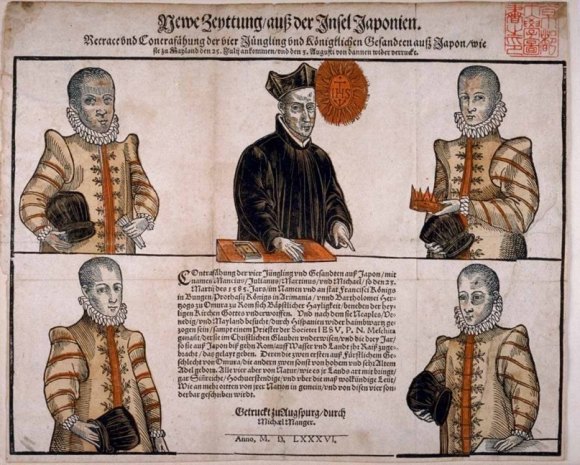In 1597, Japan was reaching the end of the Warring States period and starting to unify under the rule of Oda Nobunaga and Toyotomi Hideyoshi. At the same time, which was 15 years after the Tenshô embassy (the first Japanese embassy to Europe), three Japanese men were completing their (unwilling) journey to Mexico, of all places.
Using records from the Inquisition found in the National Library of Mexico, Lucio de Sousa (University of Evora in Portugal) and Oka Mihoko (University of Tokyo) have discovered conclusive proof of the men’s journey to the New World. They’ve also managed to piece together a few details of their stories.
While the records do not list their Japanese names, the entries for the men indicated that they were from Japan. Instead of their birth names, it seems that they were called “Gaspar Fernandez,” “Miguel,” and “Ventura.” (Hmmm…do you think this will lead to a new baby-name trend in Japan?)
It seems that Gaspar, born in Oita Prefecture (in Kyuushu, off the main island of Japan), was sold by a Japanese slave trader to Perez, a Portuguese slave trader, at the age of eight for a three-year contract. The price? Seven pesos (at the time, a bottle of high quality olive oil was going for 8 pesos. Yikes!).
While nothing of Ventura’s history is known, records indicate that Miguel was brought by a Portuguese slave trader to Spanish territory and sold to Perez in Manila in 1594.
In 1596, Perez was arrested by the authorities on suspicion of being secretly Jewish. After being found guilty, Perez and his entire family (slaves included) were sent out of Manila in December 1597 and across the Pacific to Acapulco, Mexico. It was in the interrogation records that information regarding the three Japanese slaves was found.
▼Acapulco doesn’t look so bad…
Gaspar testified at the hearing and provided evidence of Perez’s religious beliefs. After ending up in Mexico, Gaspar and Ventura complained to the authorities and were freed in 1599.
Unfortunately, that seems to be all we know of the men. While it is certainly a sad tale in nearly every way possible, there is a glimmer of beauty to it. After all, this was a time during which few people ever left their home countries—let alone circumnavigated the globe! Still, it was probably poor consolation for them. We can’t imagine what Mexico must have been like in the summer without air conditioning.
Source: Yahoo! News Japan
Image source: Wikipedia (top image), Wikimedia (image of sunset in Acapulco)
Note: the featured image is of the Tenshô Embassy, not the Japanese men who ended up in Mexico.



 Volunteers cleaned up 45 tons of garbage from Manila Bay beach, restored it to its former glory
Volunteers cleaned up 45 tons of garbage from Manila Bay beach, restored it to its former glory Japanese school’s ethics text encourages kids to “work without reward,” gets slammed online
Japanese school’s ethics text encourages kids to “work without reward,” gets slammed online Even samurai ran late! Newly discovered document shows one warrior’s excuse to his boss
Even samurai ran late! Newly discovered document shows one warrior’s excuse to his boss “A Taste of Japan”: Mouth-watering video of one man’s incredible gourmet trip 【Video】
“A Taste of Japan”: Mouth-watering video of one man’s incredible gourmet trip 【Video】 Sushi tacos now on sale in Japan — Can this cross-cultural cuisine please our biggest taco fan?
Sushi tacos now on sale in Japan — Can this cross-cultural cuisine please our biggest taco fan? McDonald’s new Happy Meals offer up cute and practical Sanrio lifestyle goods
McDonald’s new Happy Meals offer up cute and practical Sanrio lifestyle goods All-you-can-drink Starbucks and amazing views part of Tokyo’s new 170 meter-high sky lounge
All-you-can-drink Starbucks and amazing views part of Tokyo’s new 170 meter-high sky lounge McDonald’s Japan releases a pancake pie for new retro kissaten coffeeshop series
McDonald’s Japan releases a pancake pie for new retro kissaten coffeeshop series Super Nintendo World expansion gets delayed for several months at Universal Studios Japan
Super Nintendo World expansion gets delayed for several months at Universal Studios Japan Studio Ghibli glasses cases let anime characters keep an eye on your spectacles
Studio Ghibli glasses cases let anime characters keep an eye on your spectacles Is the new Shinkansen Train Desk ticket worth it?
Is the new Shinkansen Train Desk ticket worth it? Kyoto’s 100 Demons yokai monster parade returns!
Kyoto’s 100 Demons yokai monster parade returns! Hamster abandoned at Tokyo ramen restaurant gets new home
Hamster abandoned at Tokyo ramen restaurant gets new home Daiso opens massive new 25,392-square foot Tokyo flagship store with its two sub-brands included
Daiso opens massive new 25,392-square foot Tokyo flagship store with its two sub-brands included Beautiful Sailor Moon manhole cover coasters being given out for free by Tokyo tourist center
Beautiful Sailor Moon manhole cover coasters being given out for free by Tokyo tourist center Disney princesses get official manga makeovers for Manga Princess Cafe opening in Tokyo
Disney princesses get official manga makeovers for Manga Princess Cafe opening in Tokyo More foreign tourists than ever before in history visited Japan last month
More foreign tourists than ever before in history visited Japan last month Starbucks reopens at Shibuya Scramble Crossing with new look and design concept
Starbucks reopens at Shibuya Scramble Crossing with new look and design concept Beautiful new Final Fantasy T-shirt collection on the way from Uniqlo【Photos】
Beautiful new Final Fantasy T-shirt collection on the way from Uniqlo【Photos】 Foreign English teachers in Japan pick their favorite Japanese-language phrases【Survey】
Foreign English teachers in Japan pick their favorite Japanese-language phrases【Survey】 Japanese convenience store packs a whole bento into an onigiri rice ball
Japanese convenience store packs a whole bento into an onigiri rice ball We try out “Chan Ramen”, an underground type of ramen popular in the ramen community
We try out “Chan Ramen”, an underground type of ramen popular in the ramen community Studio Ghibli releases Kiki’s Delivery Service chocolate cake pouches in Japan
Studio Ghibli releases Kiki’s Delivery Service chocolate cake pouches in Japan Japan’s bone-breaking and record-breaking roller coaster is permanently shutting down
Japan’s bone-breaking and record-breaking roller coaster is permanently shutting down New definition of “Japanese whiskey” goes into effect to prevent fakes from fooling overseas buyers
New definition of “Japanese whiskey” goes into effect to prevent fakes from fooling overseas buyers Our Japanese reporter visits Costco in the U.S., finds super American and very Japanese things
Our Japanese reporter visits Costco in the U.S., finds super American and very Japanese things Studio Ghibli unveils Mother’s Day gift set that captures the love in My Neighbour Totoro
Studio Ghibli unveils Mother’s Day gift set that captures the love in My Neighbour Totoro Foreign passenger shoves conductor on one of the last full runs for Japan’s Thunderbird train
Foreign passenger shoves conductor on one of the last full runs for Japan’s Thunderbird train Domino’s Japan now sells…pizza ears?
Domino’s Japan now sells…pizza ears? New Japanese KitKat flavour stars Sanrio characters, including Hello Kitty
New Japanese KitKat flavour stars Sanrio characters, including Hello Kitty Kyoto creates new for-tourist buses to address overtourism with higher prices, faster rides
Kyoto creates new for-tourist buses to address overtourism with higher prices, faster rides Sales of Japan’s most convenient train ticket/shopping payment cards suspended indefinitely
Sales of Japan’s most convenient train ticket/shopping payment cards suspended indefinitely Sold-out Studio Ghibli desktop humidifiers are back so Totoro can help you through the dry season
Sold-out Studio Ghibli desktop humidifiers are back so Totoro can help you through the dry season Japanese government to make first change to romanization spelling rules since the 1950s
Japanese government to make first change to romanization spelling rules since the 1950s Ghibli founders Toshio Suzuki and Hayao Miyazaki contribute to Japanese whisky Totoro label design
Ghibli founders Toshio Suzuki and Hayao Miyazaki contribute to Japanese whisky Totoro label design Doraemon found buried at sea as scene from 1993 anime becomes real life【Photos】
Doraemon found buried at sea as scene from 1993 anime becomes real life【Photos】 Tokyo’s most famous Starbucks is closed
Tokyo’s most famous Starbucks is closed One Piece characters’ nationalities revealed, but fans have mixed opinions
One Piece characters’ nationalities revealed, but fans have mixed opinions We asked a Uniqlo employee what four things we should buy and their suggestions didn’t disappoint
We asked a Uniqlo employee what four things we should buy and their suggestions didn’t disappoint Princesses, fruits, and blacksmiths: Study reveals the 30 most unusual family names in Japan
Princesses, fruits, and blacksmiths: Study reveals the 30 most unusual family names in Japan Japanese netizens rewrite fairy tales in modern corporate situations so real they make us weep
Japanese netizens rewrite fairy tales in modern corporate situations so real they make us weep Tokyo museum’s current exhibition offers a dose of retro style and romance from 100 years ago
Tokyo museum’s current exhibition offers a dose of retro style and romance from 100 years ago World War II ended 70 years ago — here’s the planned US invasion of Japan that never happened
World War II ended 70 years ago — here’s the planned US invasion of Japan that never happened Japanese teacher suspended for selling a lot of cows without telling the school
Japanese teacher suspended for selling a lot of cows without telling the school Hugh Jackman stars, sings J-pop cover, and speaks Japanese in ads for Toyota【Videos】
Hugh Jackman stars, sings J-pop cover, and speaks Japanese in ads for Toyota【Videos】 Japanese nerds pick the feudal warlord they’d most like to be their boss
Japanese nerds pick the feudal warlord they’d most like to be their boss Surreal samurai art exhibition mixes the historical with the bizarre
Surreal samurai art exhibition mixes the historical with the bizarre Which Japanese convenience store sells the best beef stew?【Taste test】
Which Japanese convenience store sells the best beef stew?【Taste test】 Awe-inspiring coin sculpture erected during boring holiday
Awe-inspiring coin sculpture erected during boring holiday French Olympic announcer in hot water for calling Japanese gymnasts “little Pikachus”
French Olympic announcer in hot water for calling Japanese gymnasts “little Pikachus” Cardcaptor Sakura Fan in Peru Gets Guinness World Record For Largest Collection
Cardcaptor Sakura Fan in Peru Gets Guinness World Record For Largest Collection Second time the charm? Rumiko Takahashi nominated for Will Eisner Comic Awards Hall of Fame!
Second time the charm? Rumiko Takahashi nominated for Will Eisner Comic Awards Hall of Fame! Japanese supermarket’s recruitment ad is so stringent, it’s probably looking for a robot
Japanese supermarket’s recruitment ad is so stringent, it’s probably looking for a robot “Do you have a lot of money?” Japanese kid crushes day care worker with innocent cruelty
“Do you have a lot of money?” Japanese kid crushes day care worker with innocent cruelty Short video looks at why Japanese students serve their own school lunches, clean their classrooms
Short video looks at why Japanese students serve their own school lunches, clean their classrooms
Leave a Reply